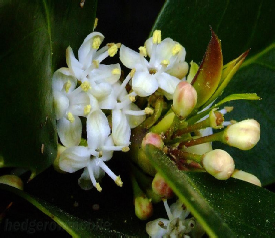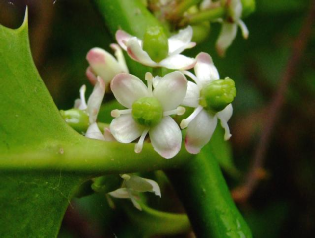07January 2020
Page topic: Sexing Hollies
ILEX (holly) (A contribution from Winston Winters) (26 May 2014)
Hollies are a large and varied genus, containing both evergreen and deciduous species.
Male and female flowers are generally borne on separate trees and this means that trees of both sexes must be present before berries are produced. Exceptions are with ‘J C van Tol’ and ‘Pyramidalis’.
In districts where hollies are common there is generally no problem with pollination.
Hollies are tolerant of shade but then growth is usually more open and untidy and on female trees fruiting becomes less abundant and sometimes the tree becomes sterile.
Propagation
1. By seed sown in a cold frame or seedbed from October to March
2. By grafting in mid-
3. By layering branches in late winter or early spring
4. By heel cuttings of half-
Question:
How can I tell a male holly from a female holly? That is, how do you distinguish a male holly shrub from a female holly shrub, using their respective flower structures to make the identification?
Answer:
You have one holly shrub in your garden, and it has never produced berries; you learn that hollies need a mate, so you correctly reason that the lack of berry production must be attributed to one of two possible causes:
1. You have a male holly.
2. You have a female holly, but its flowers haven't been pollinated.
So now you have to determine what gender your holly is, so you can go out shopping for either a male holly or a female holly, so that pollination and reproduction can take place. The point is, though, without having the crutch of holly berries (a sure indication of the female gender in holly shrubs) to rely on for identification, how can you tell a male holly from a female holly?
The answer lies in the flowers, as male holly flowers are different from female holly flowers (of course, this limits identification to those periods when that particular type of holly comes into bloom).

Both male hollies and female hollies bear flowers that have 4 petals -
Editor’s sad note: a specimen which has both pollen and bumps that look like mini-


Male Flowers
Note the yellow pollen on the stamens and the absence of central ‘bumps’
Female Flowers
Note the big central ‘bumps’ and flimsy stamens.
This page ends here.








M mE edn e4



